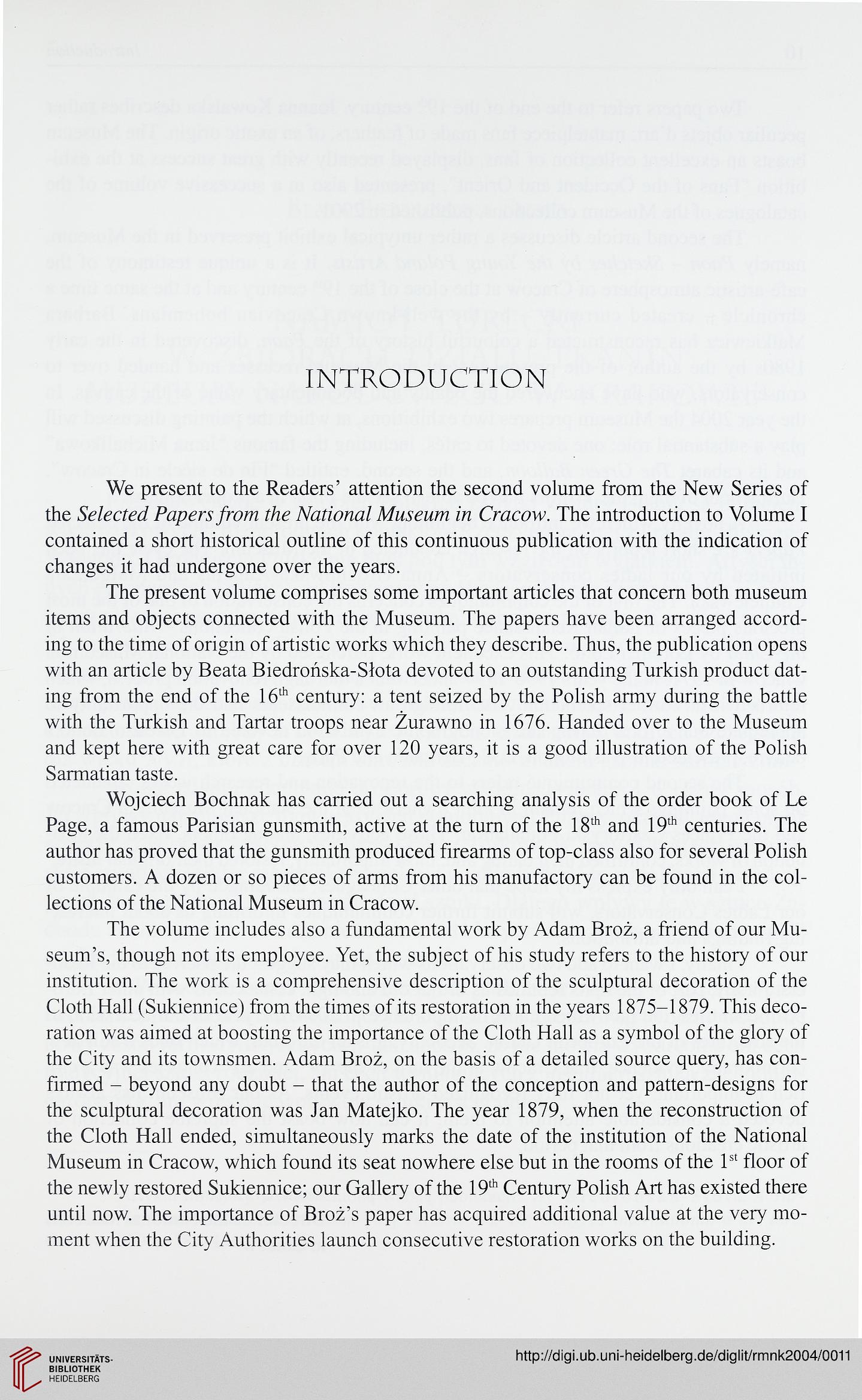INTRODUCTION
We present to the Readers’ attention the second volume from the New Series of
the Selected Papers from the National Museum in Cracow. The introduction to Volume I
contained a short historical outline of this continuous publication with the indication of
changes it had undergone over the years.
The present volume comprises some important articles that concem both museum
items and objects connected with the Museum. The papers have been arranged accord-
ing to the time of origin of artistic works which they describe. Thus, the publication opens
with an article by Beata Biedrońska-Słota devoted to an outstanding Turkish product dat-
ing from the end of the 16* century: a tent seized by the Polish army during the battle
with the Turkish and Tartar troops near Żurawno in 1676. Handed over to the Museum
and kept here with great care for over 120 years, it is a good illustration of the Polish
Sarmatian taste.
Wojciech Bochnak has carried out a searching analysis of the order book of Le
Page, a famous Parisian gunsmith, active at the turn of the 18th and 19th centuries. The
author has proved that the gunsmith produced firearms of top-class also for several Polish
customers. A dozen or so pieces of arms from his manufactory can be found in the col-
lections of the National Museum in Cracow.
The volume includes also a fundamental work by Adam Broż, a friend of our Mu-
seum’s, though not its employee. Yet, the subject of his study refers to the history of our
institution. The work is a comprehensive description of the sculptural decoration of the
Cloth Hall (Sukiennice) from the times of its restoration in the years 1875-1879. This deco-
ration was aimed at boosting the importance of the Cloth Hall as a symbol of the glory of
the City and its townsmen. Adam Broż, on the basis of a detailed source ąuery, has con-
firmed - beyond any doubt - that the author of the conception and pattem-designs for
the sculptural decoration was Jan Matejko. The year 1879, when the reconstruction of
the Cloth Hall ended, simultaneously marks the datę of the institution of the National
Museum in Cracow, which found its seat nowhere else but in the rooms of the lst floor of
the newly restored Sukiennice; our Gallery of the 19th Century Polish Art has existed there
until now. The importance of Broż’s paper has acąuired additional value at the very mo-
ment when the City Authorities launch consecutive restoration works on the building.
We present to the Readers’ attention the second volume from the New Series of
the Selected Papers from the National Museum in Cracow. The introduction to Volume I
contained a short historical outline of this continuous publication with the indication of
changes it had undergone over the years.
The present volume comprises some important articles that concem both museum
items and objects connected with the Museum. The papers have been arranged accord-
ing to the time of origin of artistic works which they describe. Thus, the publication opens
with an article by Beata Biedrońska-Słota devoted to an outstanding Turkish product dat-
ing from the end of the 16* century: a tent seized by the Polish army during the battle
with the Turkish and Tartar troops near Żurawno in 1676. Handed over to the Museum
and kept here with great care for over 120 years, it is a good illustration of the Polish
Sarmatian taste.
Wojciech Bochnak has carried out a searching analysis of the order book of Le
Page, a famous Parisian gunsmith, active at the turn of the 18th and 19th centuries. The
author has proved that the gunsmith produced firearms of top-class also for several Polish
customers. A dozen or so pieces of arms from his manufactory can be found in the col-
lections of the National Museum in Cracow.
The volume includes also a fundamental work by Adam Broż, a friend of our Mu-
seum’s, though not its employee. Yet, the subject of his study refers to the history of our
institution. The work is a comprehensive description of the sculptural decoration of the
Cloth Hall (Sukiennice) from the times of its restoration in the years 1875-1879. This deco-
ration was aimed at boosting the importance of the Cloth Hall as a symbol of the glory of
the City and its townsmen. Adam Broż, on the basis of a detailed source ąuery, has con-
firmed - beyond any doubt - that the author of the conception and pattem-designs for
the sculptural decoration was Jan Matejko. The year 1879, when the reconstruction of
the Cloth Hall ended, simultaneously marks the datę of the institution of the National
Museum in Cracow, which found its seat nowhere else but in the rooms of the lst floor of
the newly restored Sukiennice; our Gallery of the 19th Century Polish Art has existed there
until now. The importance of Broż’s paper has acąuired additional value at the very mo-
ment when the City Authorities launch consecutive restoration works on the building.





